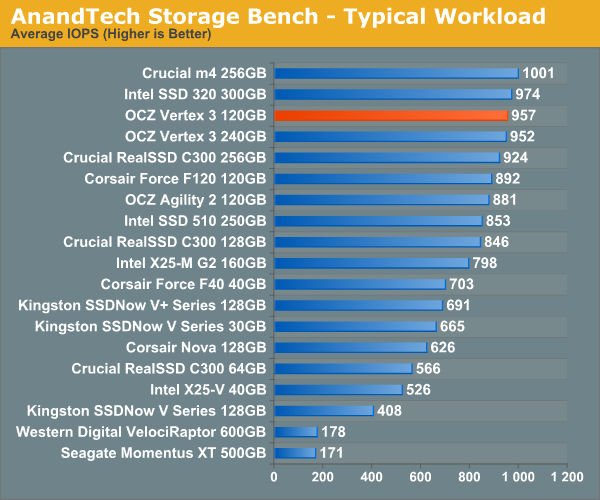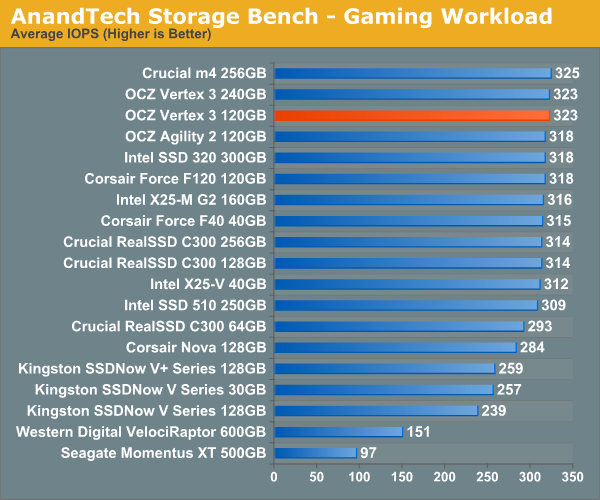The OCZ Vertex 3 Review (120GB)
by Anand Lal Shimpi on April 6, 2011 6:32 PM ESTAnandTech Storage Bench 2010
To keep things consistent we've also included our older Storage Bench. Note that the old storage test system doesn't have a SATA 6Gbps controller, so we only have one result for the 6Gbps drives.
The first in our benchmark suite is a light/typical usage case. The Windows 7 system is loaded with Firefox, Office 2007 and Adobe Reader among other applications. With Firefox we browse web pages like Facebook, AnandTech, Digg and other sites. Outlook is also running and we use it to check emails, create and send a message with a PDF attachment. Adobe Reader is used to view some PDFs. Excel 2007 is used to create a spreadsheet, graphs and save the document. The same goes for Word 2007. We open and step through a presentation in PowerPoint 2007 received as an email attachment before saving it to the desktop. Finally we watch a bit of a Firefly episode in Windows Media Player 11.
There’s some level of multitasking going on here but it’s not unreasonable by any means. Generally the application tasks proceed linearly, with the exception of things like web browsing which may happen in between one of the other tasks.
The recording is played back on all of our drives here today. Remember that we’re isolating disk performance, all we’re doing is playing back every single disk access that happened in that ~5 minute period of usage. The light workload is composed of 37,501 reads and 20,268 writes. Over 30% of the IOs are 4KB, 11% are 16KB, 22% are 32KB and approximately 13% are 64KB in size. Less than 30% of the operations are absolutely sequential in nature. Average queue depth is 6.09 IOs.
The performance results are reported in average I/O Operations per Second (IOPS):

If there’s a light usage case there’s bound to be a heavy one. In this test we have Microsoft Security Essentials running in the background with real time virus scanning enabled. We also perform a quick scan in the middle of the test. Firefox, Outlook, Excel, Word and Powerpoint are all used the same as they were in the light test. We add Photoshop CS4 to the mix, opening a bunch of 12MP images, editing them, then saving them as highly compressed JPGs for web publishing. Windows 7’s picture viewer is used to view a bunch of pictures on the hard drive. We use 7-zip to create and extract .7z archives. Downloading is also prominently featured in our heavy test; we download large files from the Internet during portions of the benchmark, as well as use uTorrent to grab a couple of torrents. Some of the applications in use are installed during the benchmark, Windows updates are also installed. Towards the end of the test we launch World of Warcraft, play for a few minutes, then delete the folder. This test also takes into account all of the disk accesses that happen while the OS is booting.
The benchmark is 22 minutes long and it consists of 128,895 read operations and 72,411 write operations. Roughly 44% of all IOs were sequential. Approximately 30% of all accesses were 4KB in size, 12% were 16KB in size, 14% were 32KB and 20% were 64KB. Average queue depth was 3.59.

The gaming workload is made up of 75,206 read operations and only 4,592 write operations. Only 20% of the accesses are 4KB in size, nearly 40% are 64KB and 20% are 32KB. A whopping 69% of the IOs are sequential, meaning this is predominantly a sequential read benchmark. The average queue depth is 7.76 IOs.











153 Comments
View All Comments
soltys - Thursday, April 14, 2011 - link
Looking at past few articles, I was wondering - what exactly do SSDs do, that random writes are significantly faster than random reads (and looking at the tables above, 2x - 3x faster) ?Even considering magic firmware + spare space + caching - sooner or later R-E-M-W will have to be performed. And random patterns, with random data should emphasize that.
Any insights or pointers ?
Norrin - Friday, April 15, 2011 - link
Hi Anand,I have the vertex 3 installed in a 2011 macbook pro.
I'm having a horrible problem where the OS locks up for about 10 seconds every 30 minutes or so.
What was the problem that cause OCZ to delay their March 3rd launch day??
What changes were made (firmware version numbers)? How can the firmware on a vertex 3 be checked and where can the latest version be downloaded and installed?
I suspect the problem I'm seeing is the same which delayed their launch. Maybe they have a firmware update available now which can be installed in the disk I currently have....
Thanks so much!
jammmet - Tuesday, April 19, 2011 - link
I am experiencing exactly the same issue - did you find a workaround? Also, do you also have a spinning HD in your machine too?typofonic - Monday, April 18, 2011 - link
Wouldn't a Vertex 3 120 GB be a really bad choice for a boot drive when it has such a low random read performance, compared to the older Force F120/Vertex, even if I have a new SATA3 MacBook Pro?I can imagine that launching applications, booting the system etc. would be much slower with this compared to a Vertex 2/Corsair Force F120. Yes, the sequential performance is much better, but wouldn't the older drives seem snappier in normal everyday use?
Even if the Vertex 3 120GB cost the same as a Vertex 2/Force F120, wouldn't the older drives still be a much better choice for normal use, because of their high random read/write? Can't decide if I should go for the Vertex 3 or the Force F120/Vertex 2.
Anybody who knows more about this?
rgbxyz - Wednesday, April 20, 2011 - link
I own a 120 GB Vertex. I've been thinking about adding another one. However, it will not be an OCZ. With the word coming, that it seems. and I stress, seems, that OCZ can not once again be trusted. And this time around it's an even bigger issue.From the just released report: "OCZ has parlayed investor and market excitement for solid state drives (SSDs) into an amazing story. From a low of $1.79 last summer, OCZ's stock has steadily climbed more than 350% on a feel good tale told by its CEO. But there is a much darker and sinister side that has been well hidden. It is our opinion that OCZ has misrepresented its SSD growth and has financial irregularities that are nearly impossible to reconcile. We believe that some form of a restatement may be required and that the auditors tick and tie review has some substantial inconsistencies. As such, we have sent our findings to the Securities and Exchange Commission asking for clarification on the multiple sets of numbers that we have uncovered. We believe OCZ's Board has the fiduciary responsibility to form a special committee to examine these discrepancies." The bottom line for those curious where this short-seller sees the stock: "If OCZ trades in-line with the comp group, a generous assumption given OCZ's limited asset value, differentiation, and minimal profitability, a reasonable price target would be between $2.58 and $4.98 per share."
http://www.scribd.com/doc/53435574/OCZ-The-Master-...
la taupe - Friday, April 22, 2011 - link
http://www.scribd.com/doc/53435574/OCZ-The-Master-...geroj - Saturday, April 23, 2011 - link
it would be interesting to see if 2 120gb ssd-s in raid0 would be better choice over a 240gb vertex3 or intel 510 (performance and costwise).im thinking of putting 2x120gb crucial c300 in raid0, it would cost 2/3rd of a 240gb vertex3 but a thorough test would be nice before deciding.
2x64gb in raid0 is also enough for me (and as i see for a lot of us) but what about the performance?
ekerazha - Wednesday, April 27, 2011 - link
New "Vertex 3 Max IOPS" series released.120 GB
Read IOPS: 20.000 -> 35.000
Write IOPS: 60.000 -> 75.000
240 GB
Read IOPS: 40.000 -> 55.000
Write IOPS: 60.000 -> 65.000
Max Write: 520 MB/s -> 500 MB/s (decrease)
sor - Friday, April 29, 2011 - link
Yeah, what the hell is this all about? Anand mentioned in his review that there was supposed to be some sort of firmware cap on iops according to sandforce, but that his test vertex3 didn't have it, and that OCZ promised that performance of the shipping drive would be identical. Turns out apparently that they had TWO versions they were going to ship, and everyone was apparently led to believe that the test review one was the same performer that everyone has been jumping on as fast as they can ship. I think we've been duped.spensar - Saturday, April 30, 2011 - link
Love the real world benchmarks, and would like to see the Vertex 2 120gb numbers put up in the comparisions as well.